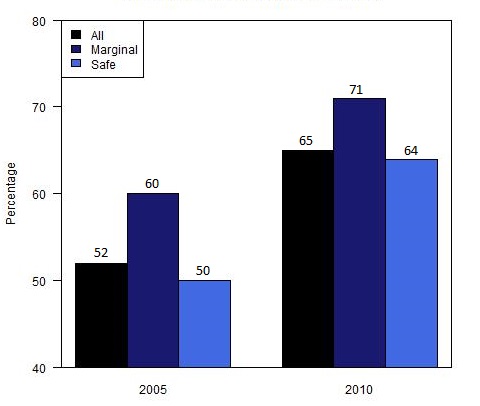Voters in marginal constituencies know more about parties’ policy positions than those in safe seats
Britain’s first past the post electoral system means that at general elections only a minority of constituencies are likely to change hands. Voters in these marginal seats, therefore, play a critical role in determining the outcome of elections. Caitlin Milazzo has examined how well-informed voters are about their choices in marginal seats, compared to those in safe seats, and shares her findings here.

In 2010, Labour’s Glenda Jackson won Hampstead & Kilburn by just 42 votes. Credit: Stephane Goldstein, CC BY-ND 2.0
Voters in marginal seats play a critical role in British elections. As Johnston and Pattie state, “The voters that matter are those who live in the places that matter – the marginal seats. Most elections are won and lost by the decisions of a small percentage of the electorate (the ‘swing voters’) in a relatively small percentage of the constituencies.” In the vast majority of British constituencies, one candidate (or party) has a comfortable majority, meaning that there is little uncertainty surrounding the outcome before the official campaign begins. Only 15% of the seats were decided by fewer than 5 percentage points in the last two elections. In these marginal seats, small changes in support can alter the outcome. Therefore, winning such seats will often decide which party forms the government. Given the importance of the marginals, parties have a strong incentive to mobilise their supporters in these areas. And indeed, there is a long line of research dating back to the 1970s demonstrating that citizens in marginal seats are more likely to turn out to vote.
While most will agree that higher turnout is preferable, casting a ballot is only part of the story. In fact, we hope that the act of voting is only the last stage of much longer process that involves becoming informed about the political choices the voter is being asked to make. With regards to these choices, political scientists have long emphasised the role that policy issues play in elections. Parties stress their policy positions during elections with the belief that this information influences how voters make their decisions. At the same time, it takes a great deal of time and effort to become (and stay) informed about political issues. Moreover, the policy convergence between the Labour and Conservatives since the late 1990s has hindered the ability of British voters to differentiate between parties on policy grounds; in 1987, 90%of respondents surveyed for the British Election Study (BES) indicated that they noticed “great differences” between the Conservative and Labour parties. By 2010, this number had declined to only 38%.
Given the obstacles British voters face to become informed about the policy positions of their political choices, it is perhaps unsurprising that for many citizens choose not to do so. We have only to look at the recent election surveys to find evidence that many citizens lack information about politics. In 1997, for example, 57 per cent of respondents were unable to recall the name of their incumbent MP. There is even variation in levels of factual political knowledge, with more than 50 per cent of respondents in both of the last 2 election surveys answering at least two of the BES’ true/false political knowledge questions incorrectly.
However, there is evidence to suggest that voters in marginal seats are more likely to possess the knowledge necessary to differentiate between their political choices on policy grounds. When citizens assign the correct relative policy position to parties, it signals that they not only recognize the positions of individual parties, but also that they understand how their political choices stand on a given policy, relative to each other. Therefore, having accurate knowledge of parties’ relative policy positions is important because it directly speaks to a person’s ability to determine which of the parties best represents her policy preferences.
Even if we limit the task to only the top two vote-receiving parties in each constituency, we can see that many voters find relative positioning of parties to be quite difficult 9see Figure One). Using a BES question that asks voters to place each party of the left/right scale, only 52% of voters were able to place to determine the correct ideological placement of the top two parties in their constituency in 2005. In 2010, it is increases to 65%. However, if we compare citizens in marginal and safe seats, we see big differences. In 2005, there was a 10% difference; 60% of voters could place the top two parties in the correct order in seats where the election was decided by less than 5% of votes vs. only 50% in safe seats. We see a similar effect in 2010; 71% of citizens in marginal seats are able to correctly order the parties, compared with 64% of citizens in safe seats.
Figure One: Voters placing parties in the correct ideological order, 2005 and 2010 UK general elections (%)
There are two possible explanations for why citizens are more knowledgeable in marginal seats. One is that parties devote more campaign attention to the marginals. This will often include distributing campaign leaflets. Because leaflets frequently provide information about parties’ policy positions, the increased campaign attention may decrease the effort citizens have to devote to becoming informed; the information is delivered directly to their door. Marginality may also encourage citizens to become engaged in the race by increasing the importance of the constituency in determining who forms the government. As a result, citizens may have greater incentive to become informed about their choices. And, a more nuanced analysis of the BES data from the two elections indicates that marginality promotes policy knowledge in both ways. Moreover, in both elections, the effect of marginality on knowledge is non-trivial; rather, it is comparable to effects of a number of important individual-level characteristics, such as income and education.
Because citizens in marginal constituencies tend to have more accurate knowledge of parties’ policy positions, they should be better equipped to select the party with the issue positions that best represents with their own preferences. Given that voters in these constituencies are the ones that frequently decide who forms the government, their ability to assess parties’ relative policy positions means that citizens get it right when it counts. Therefore, while levels of political knowledge may remain low overall, we can take comfort in the fact that voters in the seats that decide elections are better able to select parties based on policy, and their ability to do so may increase the policy responsiveness between citizens and elites.
—
Note: This post represents the views of the author and does not give the position of Democratic or LSE. Please read our comments policy before responding. Shortlink for this post: buff.ly/1pOAadX
—
 Caitlin Milazzo is a Lecturer in Politics at the University of Nottingham. Visit her website here.
Caitlin Milazzo is a Lecturer in Politics at the University of Nottingham. Visit her website here.






 Democratic Audit's core funding is provided by the Joseph Rowntree Charitable Trust. Additional funding is provided by the London School of Economics.
Democratic Audit's core funding is provided by the Joseph Rowntree Charitable Trust. Additional funding is provided by the London School of Economics.
Voters in marginal seats are relatively well-informed about party policies. Good job, since they decide elections https://t.co/qc9Yql9sTM
With Epsom being a safe seat. Will you be neglected next year at the GE? https://t.co/bjgbhC448q @democraticaudit #blenheimpolitics
Voters in marginal constituencies know more abt parties’ policy positions than those in safe seats : Democratic Audit https://t.co/5Ert5gsIAx
Voters in marginal seats decide elections. At least they are relatively well-informed https://t.co/UtMI7HeqrY
Voters in marginal constituencies know more about parties’ policy positions than those in safe seats https://t.co/EGTiO1bGDr
Voters in marginal seats are more informed about policy. My new piece for @democraticaudit: https://t.co/kGalnboyfk
RT @PJDunleavy: Voters in UK marginal constituencies know more about parties’ policy positions than those in safe seats https://t.co/RpRCzz5…
Voters in marginal constituencies know more about parties’ policy positions than those in safe seats https://t.co/kAqyVFbT9C